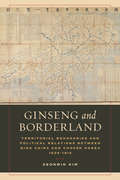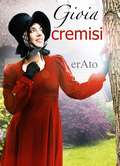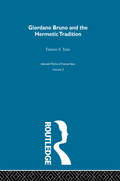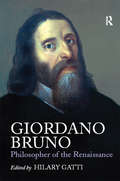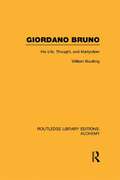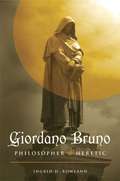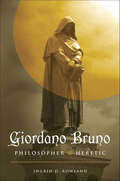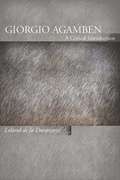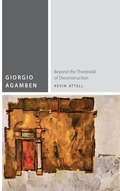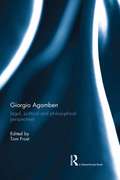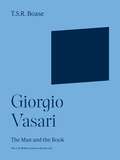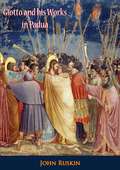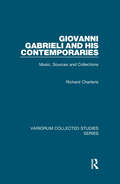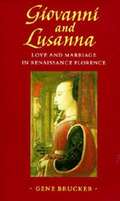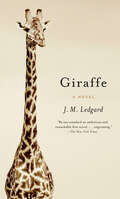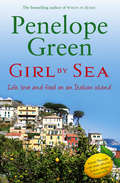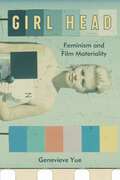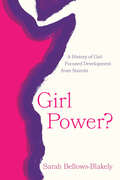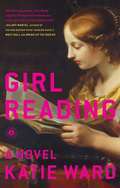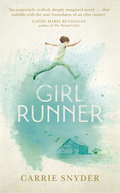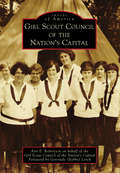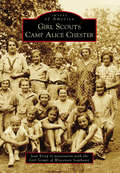- Table View
- List View
Gino Germani
by Ana GermaniDesde el joven que abandonó su Italia natal huyendo de la persecución fascista hasta el profesional internacionalmente reconocido que emprende otra vez el camino del exilio -esta vez al mundo académico estadounidense-, la vida de Gino Germani puede concebirse como la de un auténtico liberal en lucha permanente contra toda forma de totalitarismo. Es que el fundador de la Sociología científica en la Argentina estaba convencido de que una sociedad democrática era condición sine qua non para el pleno desarrollo de la ciencia. Y Germani era un científico cabal, que bregó sin descanso por una Sociología basada en fundamentos empíricos y alejada de cualquier forma de retórica. Vivió y llevó a cabo su actividad profesional en la Argentina durante uno de los períodos más fecundos en el desarrollo de las ciencias sociales locales y fue protagonista indiscutido de ese proceso, generador de debates vitales que siguen siendo punto de referencia entre quienes se dedican a esas disciplinas. Ana Germani ha escrito una minuciosa biografía intelectual que reconstruye el clima de esa época convulsionada y prolífica. Numerosos documentos inéditos y testimonios de los intelectuales que protagonizaron el movimiento cultural de los años cuarenta, cincuenta y sesenta contribuyen a iluminar la figura y la obra de un científico que ha dejado huellas indelebles en el campo de estudio de la sociedad argentina.
Ginseng and Borderland: Territorial Boundaries and Political Relations Between Qing China and Choson Korea, 1636-1912
by Seonmin KimAt publication date, a free ebook version of this title will be available through Luminos, University of California Press’s Open Access publishing program. Visit www.luminosoa.org to learn more. Ginseng and Borderland explores the territorial boundaries and political relations between Qing China and Choson Korea during the period from the early seventeenth to the late nineteenth centuries. By examining a unique body of materials written in Chinese, Manchu, and Korean, and building on recent studies in New Qing History, Seonmin Kim adds new perspectives to current understandings of the remarkable transformation of the Manchu Qing dynasty (1636–1912) from a tribal state to a universal empire. This book discusses early Manchu history and explores the Qing Empire’s policy of controlling Manchuria and Choson Korea. Kim also contributes to theKorean history of the Choson dynasty (1392–1910) by challenging conventional accounts that embrace a China-centered interpretation of the tributary relationship between the two polities, stressing instead the agency of Choson Korea in the formation of the Qing Empire. This study demonstrates how Koreans interpreted and employed this relationship in order to preserve the boundary—and peace—with the suzerain power. By focusing on the historical significance of the China-Korea boundary, this book defines the nature of the Qing Empire through the dynamics of contacts and conflicts under both the cultural and material frameworks of its tributary relationship with Choson Korea.
Gioia cremisi
by EratoA parte la felicità, lei ha tutto ciò che ha sempre desiderato. Lady Agnes Rowereigh sapeva da tutta la vita che era suo dovere sposarsi con un buon partito e rendere felice un uomo e si era dedicata con entusiasmo a questo percorso. Ma quando incontra il famoso donnaiolo Visconte Winthrope, sperimenta una gioia e una passione che non aveva mai conosciuto prima. L'unico problema? Lei è già sposata con Sir Howard Rowereigh. Un racconto commovente e drammatico che porta il lettore in un mondo in cui i sogni diventano realtà, anche se accadono troppo tardi.
Giordano Bruno & Hermetic Trad (Routledge Classics Ser.)
by Frances A. YatesFirst published in 1999. Routledge is an imprint of Taylor & Francis, an informa company.
Giordano Bruno: Giordano Bruno In England (Routledge Library Editions: Alchemy Ser.)
by Hilary GattiGiordano Bruno was burnt at the stake in Rome in 1600, accused of heresy by the Inquisition. His life took him from Italy to Northern Europe and England, and finally to Venice, where he was arrested. His six dialogues in Italian, which today are considered a turning point towards the philosophy and science of the modern world, were written during his visit to Elizabethan London, as a gentleman attendant to the French Ambassador, Michel de Castelnau. He died refusing to recant views which he defined as philosophical rather than theological, and for which he claimed liberty of expression. The papers in this volume derive from a conference held in London to commemorate the 400th anniversary of Bruno's death. A number focus specifically on his experience in England, while others look at the Italian context of his thought and his impact upon others. Together they constitute a major new survey of the range of Bruno's philosophical activity, as well as evaluating his use of earlier cultural traditions and his influence on both contemporary and more modern themes and trends.
Giordano Bruno: His Life, Thought, and Martyrdom (Routledge Library Editions: Alchemy)
by William BoultingThis comprehensive book outlines the life and works of an important revolutionary intellectual of the 16th Century. This book follows Bruno’s life and the development of his thought in the order in which he declared it. Giordano Bruno was an Italian Dominican friar, philosopher, mathematician and astronomer. He was burned at the stake after the Roman Inquisition found him guilty of heresy but his modern scientific thought and cosmology became very influential. His writings on science also showed interest in magic and alchemy and those are outlined in this book alongside what he is most remembered for - his place in the history of the relationship between science and faith.
Giordano Bruno: Philosopher / Heretic
by Ingrid D. RowlandGiordano Bruno is one of the great figures of early modern Europe, and one of the least understood. Ingrid D. Rowland's pathbreaking life of Bruno establishes him once and for all as a peer of Erasmus, Shakespeare, and Galileo, a thinker whose vision of the world prefigures ours. By the time Bruno was burned at the stake as a heretic in 1600 on Rome's Campo dei Fiori, he had taught in Naples, Rome, Venice, Geneva, France, England, Germany, and the & magic Prague of Emperor Rudolph II. His powers of memory and his provocative ideas about the infinity of the universe had attracted the attention of the pope, Queen Elizabeth--and the Inquisition, which condemned him to death in Rome as part of a year long jubilee. Writing with great verve and sympathy for her protagonist, Rowland traces Bruno's wanderings through a sixteenth-century Europe where every certainty of religion and philosophy had been called into question and shows him valiantly defending his ideas (and his right to maintain them) to the very end. An incisive, independent thinker just when natural philosophy was transformed into modern science, he was also a writer of sublime talent. His eloquence and his courage inspired thinkers across Europe, finding expression in the work of Shakespeare and Galileo. Giordano Bruno allows us to encounter a legendary European figure as if for the first time.
Giordano Bruno: Philosopher/Heretic
by Ingrid D. Rowland“Ingrid D. Rowland brings before us today the pieces of an extraordinary sixteenth-century life . . . This is intellectual biography at its best.” —Peter N. Miller, The New RepublicGiordano Bruno is one of the great figures of early modern Europe, and one of the least understood. Ingrid D. Rowland's pathbreaking life of Bruno establishes him once and for all as a peer of Erasmus, Shakespeare, and Galileo, a thinker whose vision of the world prefigures ours.By the time Bruno was burned at the stake as a heretic in 1600 on Rome's Campo dei Fiori, he had taught in Naples, Rome, Venice, Geneva, France, England, Germany, and the “magic Prague” of Emperor Rudolph II. His powers of memory and his provocative ideas about the infinity of the universe had attracted the attention of the pope, Queen Elizabeth—and the Inquisition, which condemned him to death in Rome as part of a yearlong jubilee.Writing with great verve and sympathy for her protagonist, Rowland traces Bruno's wanderings through a sixteenth-century Europe where every certainty of religion and philosophy had been called into question and shows him valiantly defending his ideas (and his right to maintain them) to the very end. An incisive, independent thinker just when natural philosophy was transformed into modern science, he was also a writer of sublime talent. His eloquence and his courage inspired thinkers across Europe, finding expression in the work of Shakespeare and Galileo.Giordano Bruno allows us to encounter a legendary European figure as if for the first time.“A loving and thoughtful account of [Bruno’s] life and thought, satires and sonnets, dialogues and lesson plans, vagabond days and star-spangled nights.” —John Leonard, Harper’s
Giorgio Agamben
by Leland de la DurantayeGiorgio Agamben is a philosopher well known for his brilliance and erudition, as well as for the difficulty and diversity of his seventeen books. The interest which hisHomo Sacersparked in America is likely to continue to grow for a great many years to come. Giorgio Agamben: A Critical Introductionpresents the complexity and continuity of Agamben's philosophy-and does so for two separate and distinct audiences. It attempts to provide readers possessing little or no familiarity with Agamben's writings with points of entry for exploring them. For those already well acquainted with Agamben's thought, it offers a critical analysis of the achievements that have marked it.
Giorgio Agamben: Beyond the Threshold of Deconstruction (Commonalities)
by Kevin AttellAgamben’s thought has been viewed as descending primarily from the work of Heidegger, Benjamin, and, more recently, Foucault. This book complicates and expands that constellation by showing how throughout his career Agamben has consistently and closely engaged (critically, sympathetically, polemically, and often implicitly) the work of Derrida as his chief contemporary interlocutor.The book begins by examining the development of Agamben’s key concepts—infancy, Voice, potentiality—from the 1960s to approximately 1990 and shows how these concepts consistently draw on and respond to specific texts and concepts of Derrida. The second part examines the political turn in Agamben’s and Derrida’s thinking from about 1990 onward, beginning with their investigations of sovereignty and violence and moving through their parallel treatments of juridical power, the relation between humans and animals, and finally messianism and the politics to come.
Giorgio Agamben: Legal, Political and Philosophical Perspectives
by Tom FrostThis book collects new contributions from an international group of leading scholars – including many who have worked closely with Agamben – to consider the impact of Agamben’s thought on research in the humanities and social sciences. Giorgio Agamben: Legal, Political and Philosophical Perspectives addresses the potential of Agamben’s thought by re-focusing attention away from his critiques of Western politics and towards his scheme for a political future. Part I of the book draws upon a wide range of issues such as legal oaths, legal reasoning and Christian conceptions of love in order to examine the potential for Agamben’s work to impact upon future legal scholarship. Part II focuses on political perspectives that include references to Marx, Rousseau and Agamben’s conception of the ‘messianic’. Theology, biology, and the thought of Gilles Deleuze, Walter Benjamin and Antonin Artaud are all drawn upon in Part III to explore philosophical perspectives in Agamben’s thought. This book demonstrates the importance and originality of Giorgio Agamben, who has articulated a vision of politics that must be recognised as an influential contribution to modern philosophical and political thinking. It is a book that will be of considerable interest to many working across the humanities and social sciences.
Giorgio Vasari: The Man and the Book (The A. W. Mellon Lectures in the Fine Arts #20)
by Thomas Sherrer BoaseA striking account of Vasari’s career, friendships, and contribution to the art of the Italian RenaissanceVasari’s Lives of the Most Excellent Architects, Painters, and Sculptors, first published in 1550, fixed for three hundred years general European views about the art of the Renaissance, and its influence still lingers today. While much has been written about Vasari’s writings, comparatively few full-length studies have dealt with the man himself. In this book, T.S.R. Boase offers a compelling account of Vasari’s life and career. At the same time, Boase explores Vasari’s ideas about the art and artists he described in the two editions of his Lives, placing these reflections in their contemporary context and later developments in art history and criticism. The result is an important appraisal of Vasari’s achievement, which despite its imperfections is without parallel in the history of Western art.
Giotto and his Works in Padua: Being An Explanatory Notice Of The Series Of Woodcuts Executed For The Arundel Society After The Frescoes In The Arena Chapel (classic Reprint)
by John Ruskin“The Arena Chapel in Padua was completed in 1303; Giotto, then considered the preeminent painter in Italy, was commissioned to paint it in 1306. The resulting fresco cycle, detailing the history, birth, life, and death of Christ, ranks among the greatest artworks ever created.John Ruskin helped redefine art criticism in the nineteenth century through his attention to detail, his playful and engaging prose, and the conviction with which he discussed the subjects that mattered most to him. Ruskin’s ekphrastic writing became a way for readers to approach the experience of looking at great art without actually seeing it in person. Despite having written about Giotto on numerous occasions in Stones of Venice and Modern Painters, he never treated the Arena Chapel in its own right. Here Ruskin examines the panels and brings them life, describing their many hidden details, all the result of Giotto’s unrivaled genius. As Ruskin says, “Giotto was…one of the greatest men who ever lived.”Long out of print, the Arundel Society first published Giotto and His Works in Padua between 1853 and 1860. It stands as Ruskin’s most compelling set of reflections on Giotto’s masterpiece—an artwork that, in Ruskin’s estimation, changed the very course of art history…The result is a book that serves not only as an introduction for students of art history, but also as a discussion of what it means to be a great artist, by one of most influential writers ever to tackle visual art.”-Print ed.
Giovanni Battista Guccia: Pioneer of International Cooperation in Mathematics
by Benedetto Bongiorno Guillermo P. CurberaThis book examines the life and work of mathematician Giovanni Battista Guccia, founder of the Circolo Matematico di Palermo and its renowned journal, the Rendiconti del Circolo matematico di Palermo. The authors describe how Guccia, an Italian geometer, was able to establish a mathematical society in Sicily in the late nineteenth century, which by 1914 would grow to become the largest and most international in the world, with one of the most influential journals of the time. The book highlights the challenges faced by Guccia in creating an international society in isolated Palermo, and places Guccia’s activities in the wider European context through comparisons with the formation of the London Mathematical Society and the creation of Mittag-Leffler’s Acta Mathematica in Stockholm. Based on extensive searches in European archives, this scholarly work follows both historical and scientific treads, and will appeal to those interested in the history of mathematics and science in general.
Giovanni Gabrieli and His Contemporaries: Music, Sources and Collections (Variorum Collected Studies #965)
by Richard CharterisFor more than three decades Richard Charteris has researched European music, sources and collections, focusing particularly on late Renaissance England, Germany and Italy. This group of essays, many concerning previously unknown or unexplored works and materials, covers the 16th and early to mid 17th centuries. The studies involve variously 'new' compositions, music manuscripts and editions, and documents that relate to figures such as the Italians Giovanni Gabrieli, Claudio Monteverdi and Alfonso Ferrabosco the Elder, the Germans Hans Leo Hassler and Adam Gumpelzhaimer, as well as the Englishmen John Coprario, John Dowland, John Jenkins, Henry Lawes, William Lawes, Peter Philips, and the French composer Marin Marais. In addition, Charteris elucidates contemporary performance practice in relation to works by Gabrieli, investigates printed music editions that originated from the Church of St Anna, Augsburg, and evaluates materials in collections, inlcuding ones in Berlin, Hamburg, Kraków, London, Regensburg and Warsaw.
Giovanni and Lusanna: Love and Marriage in Renaissance Florence
by Gene BruckerAccount of a 1456 court case in which a woman complains her husband has just married another woman, which shows many customs and laws of love and marriage at that time.
Giraffe
by J. M. LedgardIn April 1975, forty-seven giraffes were executed in a zoo in a small Czechoslovakian town. There are no records of the event. This strange and beautiful novel tells their story from the moment of their capture in Africa, to the night when they are secretly shot one by one. From the Hardcover edition.
Girl By Sea: Love, Life and Food on an Italian Island
by Penelope GreenThe conclusion to Penelope Green's bestselling trilogy about her life in Italy that includes When in Rome and See Naples and DieFrom her rooftop terrace, Penelope looks out across the sparkling waters of the Bay of Naples, and into a garden of lemon trees and magnolias. Has her Italian dream come true? Imagine catching a ferry home and stepping onto a waterfront lined with multicoloured buildings, busy with fishing boats and couples strolling to their favourite café. For Penny and her Italian love Alfonso, the idyllic island of Procida can offer the life they are looking for. But first Penny has to find a way into its small community. One thing she has in common with the locals is a love of food, so she sets herself a goal - to master the Procidan cuisine and become more than just a visitor. Across kitchen tables, in bustling cafés, and over long lunches under vine-covered pergolas, Penny learns the art of Italian cooking, builds friendships, and discovers the rhythms and secrets of island life. 'It?s a lovely chronicle of the joys and pitfalls of moving to a small community... A charming concoction of love, food and life ? with recipes!' - The Australian Women?s Weekly'With her observant eye for detail, young Sydney-born journalist Penelope Green's account of her time living on the beautiful Italian island of Procida with her partner, Alfonso, is an endearing insight into a small community where life, love and food reign supreme' - Sunday Telegraph'interspersed with mouthwatering recipes and Procida is explored from a historical, cultural, architectural, social and heart-on-the-sleeve personal perspective. Delivered with a light and breezy tone, it's easy to consume' - Courier MailAuthor BiographyPenelope Green was born in Sydney and worked as a print journalist around Australia for a decade before moving to Rome in 2002. Her first book, When in Rome, recounts her early experiences in the Eternal City. In 2005 she moved to Naples to work for ANSAmed, a Mediterranean news service. She found an apartment in the city's colourful Spanish Quarter, worked hard at mastering the Neapolitan dialect, and writing her second travel memoir, See Naples and Die. Girl by Sea completes Penny's Italian experience as she moves to the idyllic island of Procida, across the bay from Capri, with her Italian partner, Alfonso. The couple have now returned to Australia, where they are making a new life for themselves back in the Southern hemisphere. For more information visit penelopegreen.com.au
Girl Head: Feminism and Film Materiality
by Genevieve YueGirl Head shows how gender has had a surprising and persistent role in film production processes, well before the image ever appears onscreen.For decades, feminist film criticism has focused on issues of representation: images of women in film. But what are the feminist implications of the material object underlying that image, the filmstrip itself? What does feminist analysis have to offer in understanding the film image before it enters the realm of representation?Girl Head explores how gender and sexual difference have been deeply embedded within film materiality. In rich archival and technical detail, Yue examines three sites of technical film production: the film laboratory, editing practices, and the film archive. Within each site, she locates a common motif, the vanishing female body, which is transformed into material to be used in the making of a film. The book develops a theory of gender and film materiality through readings of narrative film, early cinema, experimental film, and moving image art.This original work of feminist media history shows how gender has had a persistent role in film production processes, well before the image ever appears onscreen.
Girl Power?: A History of Girl-Focused Development from Nairobi
by Sarah Bellows-BlakelyAn examination of how, when, and why austerity capitalism and strands of feminism became intertwined, and why girl-focused programs have been at the heart of international policymaking. Girl-focused education programs have long been at the heart of international policymaking—when girls’ access to education is ensured, the reasoning goes, they are more likely to turn into productive adults who can drive economic growth. These ideas combine strands of feminism and capitalism that have a specific and understudied origin. In this book, historian Sarah Bellows-Blakely shows how a doctored study of girls’ education in East and Southern Africa led to the creation of international norms in the United Nations that would go on to guide policymaking on women’s rights and economic growth, promoting neoliberal feminist policy at the expense of other forms of gender-based justice. Focusing on the growth of free-market feminism and girl-focused economic development planning through the relationship between UNICEF and the Nairobi-based NGO FEMNET, Bellows-Blakely reveals how their joint efforts set the blueprints for linked movements of economic development and women’s rights that are still ongoing. Through a narrative of the UNICEF-FEMNET lobbying campaign, Bellows-Blakely shows how multiple, contested girl-focused visions of economic programming and gender justice became selectively erased in favor of an approach to global policy centered on the free-market construction and strategic deployment of the African “girl child.”
Girl Reading
by Katie WardSeven portraits. Seven artists. Seven girls and women reading. A young orphan poses nervously for a Renaissance maestro in medieval Siena. An artist's servant girl in seventeenth-century Amsterdam snatches a moment away from her work to lose herself in tales of knights and battles. An eighteenth century female painter completes a portrait of a deceased poetess for her lover. A Victorian medium poses with a book in one of the first photographic studios. A girl suffering her first heartbreak witnesses intellectual and sexual awakening during the Great War. A young woman reading in a bar catches the eye of a young man who takes her picture. And in the not-so-distant future a woman navigates the rapidly developing cyber-reality that has radically altered the way people experience art and the way they live.Each chapter of Katie Ward's kaleidoscopic novel takes us into a perfectly imagined tale of how each portrait came to be, and as the connections accumulate, the narrative leads us into the present and beyond. In gorgeous prose Ward explores our points of connection, our relationship to art, the history of women, and the importance of reading. This dazzlingly inventive novel that surprises and satisfies announces the career of a brilliant new writer.
Girl Runner
by Carrie SnyderAganetha Smart was a poor farm girl who could run like the wind, but this was rural Canada in the 1920s when girls didn't run, or dream of the Olympics and they certainly didn't win. Aganetha Smart was about to change all that. Girl Runner, Carrie Snyder's debut novel, is the story of Aganetha Smart, a former Olympic athlete who was famous in the 1920s, but now, at age 104, lives in a nursing home, alone and forgotten by history. For Aganetha, a competitive and ambitious woman, her life remains present and unfinished in her mind.When her quiet life is disturbed by the unexpected arrival of two young strangers, Aganetha begins to reflect on her childhood in rural Ontario and her struggles to make an independent life for herself in the city.Without revealing who they are, or what they may want from her, the visitors take Aganetha on an outing from the nursing home. As ready as ever for adventure, Aganetha's memories are stirred when the pair return her to the family farm where she was raised. The devastation of WWI and the Spanish flu epidemic, the optimism of the 1920s and the sacrifices of the 1930s play out in Aganetha's mind, as she wrestles with the confusion and displacement of the present.Part historical page-turner, part contemporary mystery, Girl Runner is an engaging and endearing story about family, ambition, athletics and the dedicated pursuit of one's passions. It is also, ultimately, about a woman who follows the singular, heart-breaking and inspiring course of her life until the very end.
Girl Running
by Annette Bay Pimentel* "A bright salutation of a story, with one determined woman at its center."--Kirkus Reviews, starred reviewThe inspiring story of the first female to run the Boston Marathon comes to life in stunningly vivid collage illustrations.Because Bobbi Gibb is a girl, she's not allowed to run on her school's track team. But after school, no one can stop her--and she's free to run endless miles to her heart's content. She is told no yet again when she tries to enter the Boston Marathon in 1966, because the officials claim that it's a man's race and that women are just not capable of running such a long distance. So what does Bobbi do? She bravely sets out to prove the naysayers wrong and show the world just what a girl can do.
Girl Scout Council of the Nation's Capital (Images of America)
by Ann Elizabeth RobertsonA treasury of photos celebrating over a century of Girl Scout history in DC, Maryland, Virginia, and West Virginia.Girl Scouting came to Washington, DC, in June 1913, when Juliette Gordon Low decided her new girls’ empowerment movement needed a national headquarters. Although the headquarters moved to New York City in 1916, the council in Washington, DC, is still actively involved in the programs, and Girl Scouts of the Nation’s Capital chronicles the evolution of Girl Scouting in the District of Columbia, Maryland, Virginia, and West Virginia from 1913 to the present. It includes photographs from the Little House, where first ladies dropped by for housekeeping demonstrations, and the teahouses, where presidents enjoyed fresh beverages and cakes graciously served by Girl Scouts. Some 200 photographs will rekindle memories of making new friends, earning badges, spending summer nights at Camp May Flather, taking road trips to Rockwood, attending freezing inaugural parades, hiking along the Chesapeake & Ohio Canal, and participating in enormous sing-alongs around the Washington Monument.
Girl Scouts Camp Alice Chester
by Jean Krieg Girl Scouts of Wisconsin SoutheastGirl Scouts of Wisconsin Southeast's Camp Alice Chester (CAC) on picturesque Booth Lake first opened its doors in 1924 after a successful fundraising effort led by Alice Chester, the first president of the Milwaukee Girl Scouts. Thousands have walked its well-worn trails, cooked over campfires, and slept in the tents and cabins. Swimming and boating activities have consistently been a major appeal for campers. The historic European-style lodge has provided a gathering place for community meals, folk dancing, dramatics, arts and crafts, and ceremonies through the decades. CAC is a unique setting where skills and confidence are strengthened and lasting friendships are formed. Since the fall of 1980, CAC has also been known as Alice Chester Center (ACC). The name change brought expanded year-round, staff-led opportunities for Girl Scouts and others to utilize it during the fall, winter, and spring seasons. Today, the accredited property encompasses 333 acres and features frontage on two lakes.

